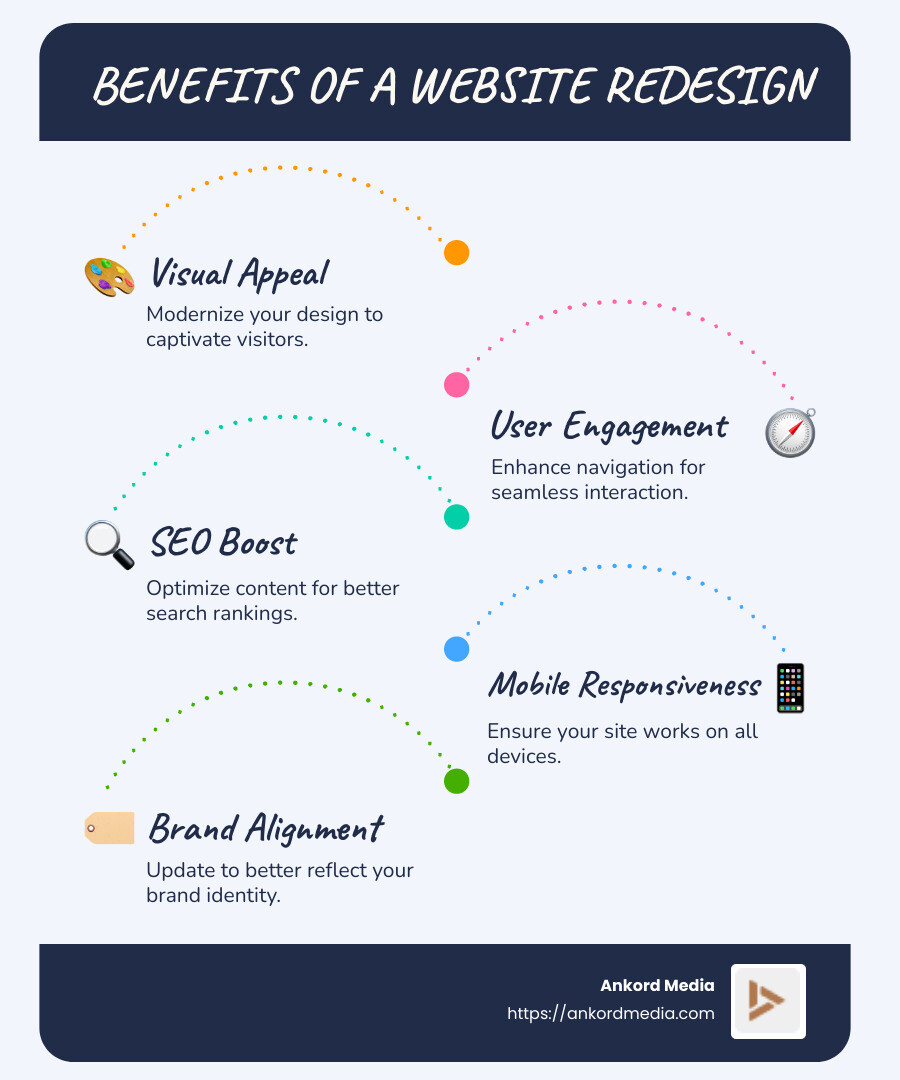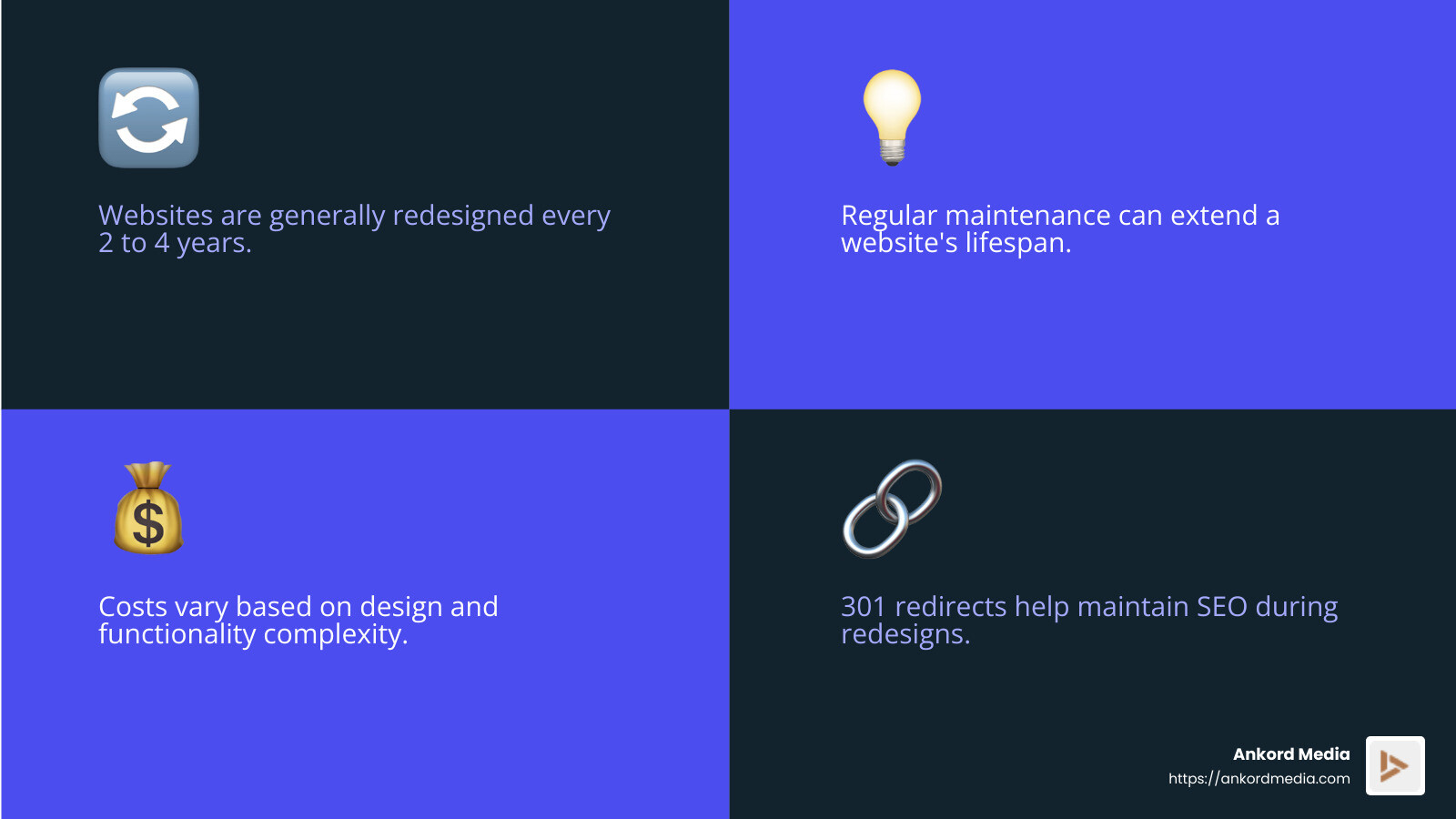Breathe New Life into Your Website: Upgrade with a Fresh Redesign

Upgrade your old website with a fresh redesign to immediately improve user experience and better align with today's dynamic digital landscape.
- Improve your site's visual appeal with a modern design.
- Improve user engagement with intuitive navigation.
- Boost SEO for higher search engine rankings.
- Ensure mobile responsiveness for a seamless experience on any device.
In today's digital environment, a website is much more than an online presence; it’s the heart of your brand's digital identity. Just like renovating an old house, upgrading your old website with a fresh redesign is not a one-click solution but a detailed, comprehensive process that ensures structural integrity while enhancing user experience. Whether your site is showing signs of slowing down or your brand message feels outdated, now is the time for digital change.
I’m Milan Kordestani, a Gen Z entrepreneur and the mind behind Ankord Media. With years of expertise, I specialize in helping businesses like yours upgrade your old website with a fresh redesign that not only refreshes your online look but strategically furthers your brand growth.

Upgrade your old website with a fresh redesign terms at a glance:
- website redesign for improved ux
- website redesign for seo
- website redesign to improve outdated ui and customer journeys
Why Upgrade Your Old Website with a Fresh Redesign
In the digital world, upgrading your old website with a fresh redesign can be a game-changer. Think of it as giving your brand a new lease on life. Here’s why it matters:
Outdated Design
An old website design can make your brand look tired and obsolete. Just as fashion trends change, so do web design trends. A website that looked cutting-edge five years ago might now seem outdated. Users expect modern aesthetics and functionalities. If they don’t find them, they might leave your site in seconds, heading straight to your competition.
A fresh redesign with updated visuals and layouts can make your site more appealing and engaging. It’s like swapping out worn-out furniture for sleek, new pieces that fit your style and needs.
Improved Functionality
Old websites often suffer from clunky navigation and slow load times. These issues frustrate users and can drive them away. When you redesign your website, you have the opportunity to improve its functionality. This means faster load times, smoother navigation, and features that work seamlessly.
For example, adding responsive design ensures that your website looks great on any device, be it a phone, tablet, or desktop. This is crucial, as more users are browsing on mobile devices than ever before.
Increased Conversions
A redesigned website can directly impact your bottom line. When users have a better experience, they are more likely to convert—whether that means making a purchase, signing up for a newsletter, or contacting you for services.
Consider this: a clear call-to-action (CTA), intuitive navigation, and engaging content can significantly boost conversion rates. By aligning your site's design with your business objectives, you create a pathway for users to follow, leading them to take the actions you desire.

In summary, upgrading your old website with a fresh redesign is not just about aesthetics; it's about functionality and conversions too. By investing in a redesign, you’re not just updating your site—you’re enhancing your brand's digital presence, making it more engaging and effective in achieving your business goals.
Steps to Upgrade Your Old Website with a Fresh Redesign
Define Clear Goals
Before diving into the redesign, it's crucial to set clear, measurable goals. These goals should align with your business objectives and guide every decision you make during the redesign process.
Start by asking: What do you want to achieve with your new website? Whether it's increasing traffic, boosting sales, or enhancing user engagement, having specific goals will help you measure success.
Example: If your goal is to increase sales, a measurable metric could be a 20% increase in online purchases within six months of launching the new site.
Conduct User Research
Understanding your users is key to a successful redesign. Conducting user research helps you learn about their needs, preferences, and pain points.
Usability testing is a valuable tool here. It involves observing real users as they interact with your website. This reveals what works well and what doesn't, allowing you to make informed changes.
Pro Tip: Record user sessions and ask participants to verbalize their thoughts. This can provide insights into their decision-making processes and highlight areas for improvement.
Develop a Content Strategy
Content is the backbone of your website. A well-thought-out content strategy ensures that your messaging is clear and aligns with user expectations.
Start with a content audit. Review existing content to identify what's working and what needs updating. This helps you maintain high-performing pages and improve or remove underperforming ones.
Next, focus on information architecture. This involves organizing your content in a way that makes it easy for users to steer and find what they're looking for.
Case Study: When Milliken revamped her site, she shifted the focus from her past to her current achievements, aligning her content with her career goals. This strategic change helped her better connect with her target audience.
Incorporating these steps will set a solid foundation for upgrading your old website with a fresh redesign. By defining goals, understanding user needs, and crafting a strategic content plan, you'll create a website that not only looks great but also supports your business objectives.
Technical Considerations for a Successful Redesign
When you decide to upgrade your old website with a fresh redesign, focusing on technical aspects is crucial. These elements ensure your website not only looks good but also performs well.
Ensure Mobile Responsiveness
In today's mobile-driven world, having a mobile-friendly website is non-negotiable. With more users accessing websites from their phones, ensuring a seamless experience across all devices is essential.
Responsive design is key. This approach allows your website to adapt to different screen sizes, providing an optimal user experience whether on a smartphone, tablet, or desktop. By implementing adaptive design principles, your site will automatically adjust to the user's device, making navigation smooth and intuitive.
Optimize for SEO
Search Engine Optimization (SEO) is vital to ensure your website ranks well on search engines like Google. Start with keyword research to understand the terms your audience is searching for. Use these keywords strategically throughout your content to attract the right visitors.
Don't forget about meta tags. These snippets of text describe your page's content and are crucial for search engines to understand what your site is about. Ensure each page has unique and descriptive meta tags to improve visibility.
Improve Website Performance
A fast-loading website is essential for keeping users engaged. Site speed affects not only user experience but also your search engine ranking. Slow websites can frustrate users and lead to higher bounce rates.
To improve performance, consider implementing caching. Caching stores copies of your site's files, reducing the server load and speeding up load times for returning visitors. Additionally, compress images and minify code to further boost your site's speed.
By focusing on these technical considerations, you'll ensure your redesigned website is not only visually appealing but also functional and efficient. This sets the stage for a successful launch and a better user experience, leading to greater satisfaction and engagement from your audience.
Design and Branding in Your Website Redesign
When you upgrade your old website with a fresh redesign, a key focus should be on design and branding. This ensures your website not only looks modern and appealing but also aligns with your brand's identity.
Update Visual Elements
Visual identity is crucial in making a lasting impression. Start by refreshing your logo. A subtle update can breathe new life into your brand, keeping it relevant while maintaining recognition.
Next, consider your color scheme. Colors evoke emotions and can influence how visitors perceive your brand. Choose a palette that reflects your brand's personality and use it consistently across your website.
Here's a quick checklist for updating visual elements:
- Refresh your logo to maintain brand recognition.
- Choose a color scheme that aligns with your brand's personality.
- Ensure consistency in fonts and imagery to reinforce your visual identity.
Focus on User Interface Design
An effective user interface (UI) is intuitive and easy to steer. This improves user experience, making visitors more likely to stay and explore your site.
Intuitive navigation is key. Users should find what they need without frustration. Organize your menu logically and use clear labels for each section.
Interactive elements can further engage users. Consider adding features like hover effects, clickable buttons, or interactive forms to make the browsing experience more dynamic and enjoyable.
Here are some tips for improving your UI design:
- Simplify navigation with clear, logical menu structures.
- Incorporate interactive elements to engage users.
- Maintain a clean layout to avoid overwhelming visitors.
By focusing on design and branding in your website redesign, you create a cohesive and engaging experience that resonates with your audience. This not only strengthens your brand identity but also encourages users to connect with your content.
Frequently Asked Questions about Website Redesign
How often should I redesign my website?
The lifespan of a website can vary, but experts generally suggest a redesign every two to four years. Simon Strande, a web development expert, notes that a well-maintained site can last even longer. However, if your site has not been properly maintained, its performance may degrade more quickly, necessitating an earlier redesign.
Maintenance is key to extending your website's life. Regular updates, bug fixes, and content refreshes help keep your site running smoothly. If technology changes significantly — like the shift to mobile-responsive design — you might need a redesign to stay current.
What are the costs involved in a website redesign?
Budget planning is crucial when considering a website redesign. Costs can vary widely based on the scope and complexity of the project. Here are some cost factors to consider:
- Design and Development: Custom designs and complex functionalities can increase costs.
- Content Creation: Updating or creating new content may require additional resources.
- SEO Optimization: Ensuring your site is optimized for search engines might involve extra expenses.
- Testing and Maintenance: Post-launch testing and ongoing maintenance should be factored into your budget.
An effective budget plan will account for these elements, ensuring you don't encounter unexpected expenses during the redesign process.
How can I ensure my redesign doesn't affect SEO?
Maintaining your site's SEO during a redesign is critical to avoid losing search engine rankings. Here are some SEO best practices to follow:
- 301 Redirects: Use 301 redirects to guide search engines from old URLs to new ones. This preserves the SEO value of your existing pages.
- Keyword Research: Ensure your new content is optimized with relevant keywords.
- Meta Tags and Headers: Update meta tags and headers to reflect your new content and design structure.
- XML Sitemap: Submit an updated XML sitemap to Google's Search Console to facilitate re-crawling.
By implementing these strategies, you can minimize the risk of negatively impacting your site's SEO during a redesign.

By addressing these common questions, you can better prepare for a successful website redesign that meets your business objectives without compromising on performance or search visibility.
Conclusion
When it comes to upgrading your old website with a fresh redesign, Ankord Media stands as a guide of innovation and creativity. Our approach to strategic branding and impactful storytelling ensures that your digital presence not only reflects your brand values but also captivates your audience.
Strategic Branding
At Ankord Media, we understand that your brand is more than just a logo or a color scheme. It’s about telling your unique story in a way that resonates with your audience. We partner with visionary clients to transform bold ideas into success, crafting digital experiences that are both authentic and engaging. Our strategic branding approach ensures that your website redesign aligns with your overall brand strategy, creating a cohesive and compelling narrative across all platforms.
Impactful Storytelling
In today’s digital landscape, impactful storytelling is key to building authentic customer connections. We leverage our expertise in design and technology to craft websites that not only look stunning but also communicate your brand story effectively. By focusing on user-centric design and clear messaging, we help you connect with your audience on a deeper level, turning visitors into loyal customers.
With a commitment to excellence and a passion for innovation, Ankord Media is here to breathe new life into your website. Whether you’re looking to improve your visual identity, improve functionality, or increase conversions, our team is ready to guide you through every step of the redesign process.
Ready to transform your digital presence? Explore our services and find how we can help you achieve your goals with a strategic and impactful website redesign.


